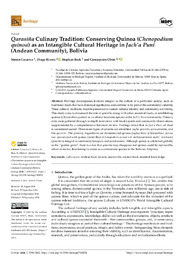Por favor, use este identificador para citar o enlazar este ítem:
https://hdl.handle.net/11000/38304
Qarasiña Culinary Tradition: Conserving Quinoa (Chenopodium quinoa) as an Intangible Cultural Heritage in Jach’a Puni (Andean Community), Bolivia
Título :
Qarasiña Culinary Tradition: Conserving Quinoa (Chenopodium quinoa) as an Intangible Cultural Heritage in Jach’a Puni (Andean Community), Bolivia |
Autor :
Cocarico, Simón
Rivera, Diego
Beck, Stephan
Obón, Concepción |
Editor :
MDPI |
Departamento:
Departamentos de la UMH::Biología Aplicada |
Fecha de publicación:
2024-09 |
URI :
https://hdl.handle.net/11000/38304 |
Resumen :
Heritage encompasses features integral to the culture of a particular society, such as
traditional foods that have historical significance and continue to be part of the community’s identity.
These culinary traditions must be preserved to sustain cultural identity and community well-being.
This study aims to document the role of qarasiña, along with other ancestral foods, in establishing
quinoa (Chenopodium quinoa) as a cultural keystone species in the Jach’a Puni community. Primary
data were gathered through in-depth interviews with local experts and community observations,
supplemented by a comprehensive literature review. Findings reveal that in Jach’a Puni, all food
is considered sacred. Three main types of qarasiña are identified: jupha qarasiña, ajara qarasiña, and
kita qarasiña. The primary ingredients are domesticated quinoa (jupha) flour (Chenopodium quinoa
var. quinoa) and wild quinoa (ajara) flour (Chenopodium quinoa var. melanospermum and C. hircinum).
Qarasiña is integral to community banquets and social events. Although quinoa is celebrated globally
as the “golden grain”, there is a risk that qarasiña may disappear and quinoa could be replaced by
wheat or maize, threatening its status as a cornerstone species in the Bolivian Altiplano.
|
Palabras clave/Materias:
jupha
ajara
Andean food
kaswira
sustain life
ancient food
ancestral knowledge |
Tipo de documento :
info:eu-repo/semantics/article |
Derechos de acceso:
info:eu-repo/semantics/openAccess |
DOI :
https://doi.org/10.3390/heritage7100254 |
Publicado en:
Heritage 2024, 7, 5390–5412 |
Aparece en las colecciones:
Artículos - Biología Aplicada
|
 La licencia se describe como: Atribución-NonComercial-NoDerivada 4.0 Internacional.
La licencia se describe como: Atribución-NonComercial-NoDerivada 4.0 Internacional.
 La licencia se describe como: Atribución-NonComercial-NoDerivada 4.0 Internacional.
La licencia se describe como: Atribución-NonComercial-NoDerivada 4.0 Internacional.
.png)
